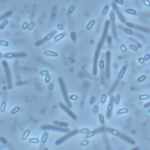Lien vers Pubmed [PMID] – 38330058
Lien vers HAL – pasteur-04449100
Lien DOI – 10.1371/journal.ppat.1012001
PLoS Pathog 2024 Feb; 20(2): e1012001
Cells are unceasingly confronted by oxidative stresses that oxidize proteins on their cysteines. The thioredoxin (Trx) system, which is a ubiquitous system for thiol and protein repair, is composed of a thioredoxin (TrxA) and a thioredoxin reductase (TrxB). TrxAs reduce disulfide bonds of oxidized proteins and are then usually recycled by a single pleiotropic NAD(P)H-dependent TrxB (NTR). In this work, we first analyzed the composition of Trx systems across Bacteria. Most bacteria have only one NTR, but organisms in some Phyla have several TrxBs. In Firmicutes, multiple TrxBs are observed only in Clostridia, with another peculiarity being the existence of ferredoxin-dependent TrxBs. We used Clostridioides difficile, a pathogenic sporulating anaerobic Firmicutes, as a model to investigate the biological relevance of TrxB multiplicity. Three TrxAs and three TrxBs are present in the 630Δerm strain. We showed that two systems are involved in the response to infection-related stresses, allowing the survival of vegetative cells exposed to oxygen, inflammation-related molecules and bile salts. A fourth TrxB copy present in some strains also contributes to the stress-response arsenal. One of the conserved stress-response Trx system was found to be present both in vegetative cells and in the spores and is under a dual transcriptional control by vegetative cell and sporulation sigma factors. This Trx system contributes to spore survival to hypochlorite and ensure proper germination in the presence of oxygen. Finally, we found that the third Trx system contributes to sporulation through the recycling of the glycine-reductase, a Stickland pathway enzyme that allows the consumption of glycine and contributes to sporulation. Altogether, we showed that Trx systems are produced under the control of various regulatory signals and respond to different regulatory networks. The multiplicity of Trx systems and the diversity of TrxBs most likely meet specific needs of Clostridia in adaptation to strong stress exposure, sporulation and Stickland pathways.











